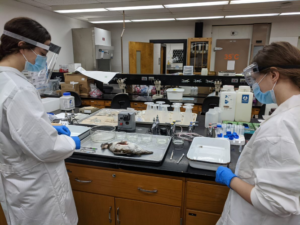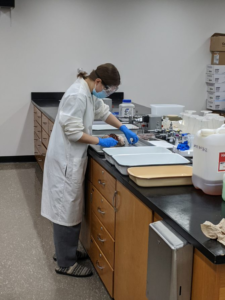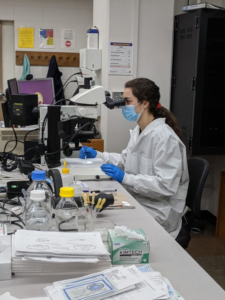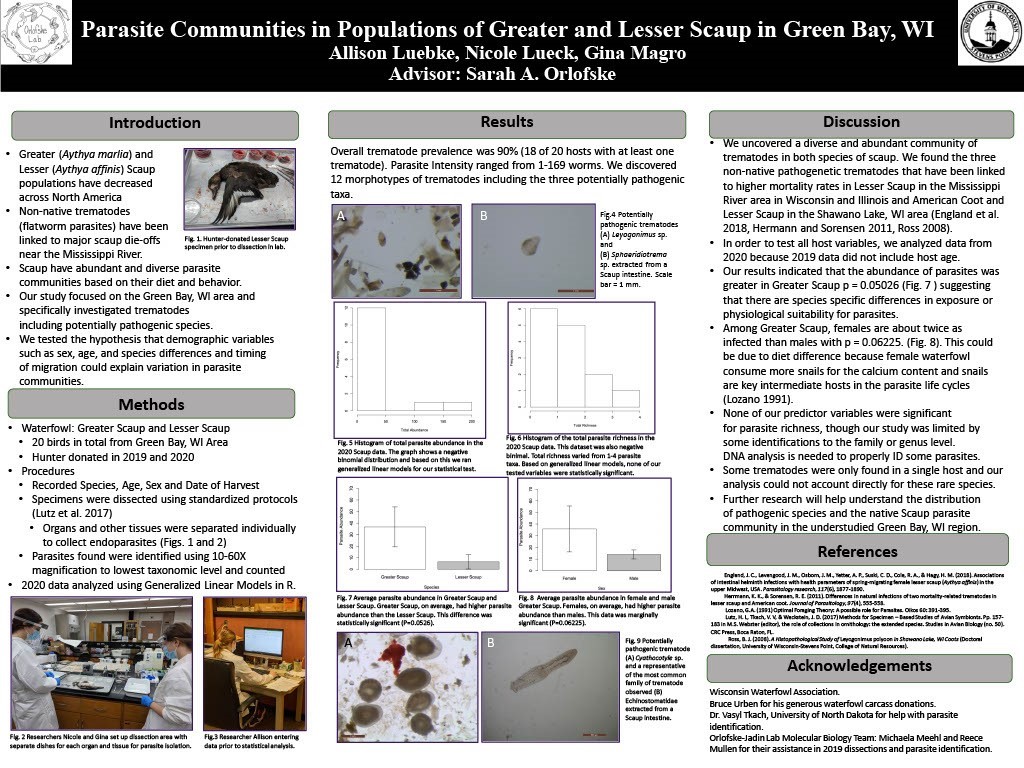Authors: Gina Magro, Allison Luebke, Nicole Lueck
This article originally appeared in Wisconsin Waterfowl Association’s May, 2021 Newsletter edition.
Editor’s note: This article was written by Dr. Sarah Orlofske’s students. Dr. Orlofske, PhD, Assistant Professor & Curator of Animal Parasites, Associate Editor Ecology, Epidemiology, Survey and Behavior, Journal of Parasitology, University of Wisconsin – Stevens Point, has contributed other articles to our newsletters regarding ducks and parasites. Read them here.
 This past fall, many hunters had a very successful season! These hunters breasted-out their birds and instead of discarding their carcasses, donated them to our research team here at UWSP (University of Wisconsin-Stevens Point). Building on the data from previous years of research and the abundance of the birds this year, we have been able to concentrate our research on the Greater and Lesser Scaup from the Green Bay area in hopes of monitoring pathogenic flatworms that may be present along with the native flatworm community. Introduced with the faucet snail, non-native pathogenic flatworms have caused large die-offs in the Mississippi River area. Understanding the roles parasites have in waterfowl is important for the conservation and management of the species.
This past fall, many hunters had a very successful season! These hunters breasted-out their birds and instead of discarding their carcasses, donated them to our research team here at UWSP (University of Wisconsin-Stevens Point). Building on the data from previous years of research and the abundance of the birds this year, we have been able to concentrate our research on the Greater and Lesser Scaup from the Green Bay area in hopes of monitoring pathogenic flatworms that may be present along with the native flatworm community. Introduced with the faucet snail, non-native pathogenic flatworms have caused large die-offs in the Mississippi River area. Understanding the roles parasites have in waterfowl is important for the conservation and management of the species.
Throughout this semester, our research team, including Dr. Orlofske and three students, used many of the ducks shot in fall 2020 and dissected them looking for parasites. We would start by taking measurements of the ducks and determine sex and age. We would also systemically ruffle feathers and collect external parasites such as mites and lice. For the internal parasite exam, we would open the body cavity of the bird and separate each of their organs. Most of the parasites found were in the digestive tract of the birds and less commonly in the trachea, lungs and liver. Greater and Lesser Scaup had an average of 23 flatworm parasites in each bird and the bird with the highest parasite intensity (or burden) had 169 total flatworm parasites! In general, female Scaup tend to have almost double the number of parasites than the male Scaup, but we will need more male scaup to examine to further test this relationship.
 This information is useful so we can help aid in keeping a healthy population of scaup and monitor how the parasite infection levels may affect the overall health of the scaup population. During the dissections of our bird samples from the Green Bay area, we found three birds infected each with one of the three major pathogenic parasites that have been linked to the Scaup die-offs near the Mississippi River. Knowing that the parasites are present within the scaup of Green Bay, we can continue to monitor the parasites and provide a baseline for future research. This was the first time our research group had detected the parasite, even though Dr. Orlofske has been dissecting birds from this area since 2018. While faucet snails have been reported in the Green Bay area, it is unclear if the birds became infected in the area or brought their parasites with them during migration.
This information is useful so we can help aid in keeping a healthy population of scaup and monitor how the parasite infection levels may affect the overall health of the scaup population. During the dissections of our bird samples from the Green Bay area, we found three birds infected each with one of the three major pathogenic parasites that have been linked to the Scaup die-offs near the Mississippi River. Knowing that the parasites are present within the scaup of Green Bay, we can continue to monitor the parasites and provide a baseline for future research. This was the first time our research group had detected the parasite, even though Dr. Orlofske has been dissecting birds from this area since 2018. While faucet snails have been reported in the Green Bay area, it is unclear if the birds became infected in the area or brought their parasites with them during migration.
 Looking into the future, we are going to continue our research on the parasites in ducks. Each year students tend to choose what their focus will be for the semester, but with the history of major die-offs it is likely we will continue to investigate the parasite load of Greater and Lesser Scaup from Wisconsin. We hopefully can expand to Scaup populations across the state of Wisconsin and aid in the understanding of the die-offs in order to keep a healthy population size to support a robust hunting season for these species.
Looking into the future, we are going to continue our research on the parasites in ducks. Each year students tend to choose what their focus will be for the semester, but with the history of major die-offs it is likely we will continue to investigate the parasite load of Greater and Lesser Scaup from Wisconsin. We hopefully can expand to Scaup populations across the state of Wisconsin and aid in the understanding of the die-offs in order to keep a healthy population size to support a robust hunting season for these species.
If you are interested in more details about our study of the parasites affecting the Scaup populations, our poster from the CNR (College of Natural Resources) Undergraduate Research symposium is below.

